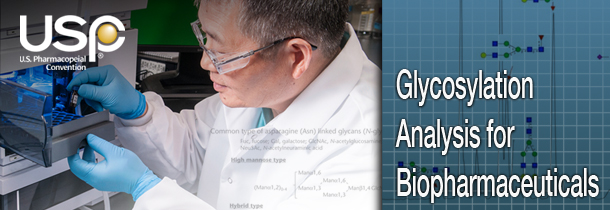
By: Trish Li and Edith Chang
Therapeutic proteins have become an effective and integral part of biopharmaceuticals used to treat certain cancers, autoimmune diseases, and hormone and enzyme deficiencies. More than 66% of therapeutic proteins are glycoproteins—proteins that contain glycans or chains of carbohydrates. These chains become attached to the protein via a post-translational modification process called glycosylation. Glycosylation plays an important role in structure, function, absorption, half-life, clearance, and safety of therapeutic proteins. However, the complex nature of glycosylation—it is heterogeneous and cell, protein, and process specific—makes it challenging to analyze and control.
Glycosylation analysis today
Because glycosylation is not driven by a template, current methods of analysis vary according to the different types of glycans and the different ways they can be linked. Current glycosylation analysis procedures are carried out during the product development stage, manufacturing process change, or as routine lot release tests. These characterizations include
- Glycosylation composition analysis: quantitatively analysis of monosaccharides (simple carbohydrates or sugars), especially the degree of sialylation;
- Glycosylation profiling: oligosaccharides (a carbohydrate composed of smaller monosaccharides) analysis; and
- Site-specific glycosylation profiling: peptide mapping which looks at protein fragments with glycans attached.
USP standards for glycosylation
As the list of biotechnology innovators and biosimilar products continues to grow, public quality standards related to glycosylation play an even more important role in ensuring the benchmark quality of these drugs. USP has developed the following general chapters which provide general guidance and/or test procedures:
- <1084> Glycoprotein and Glycan Analysis—General Consideration provides general information and became official in First Supplement to USP 34–NF 29 in 2011.
- <212> Oligosaccharide Analysis, which is official December 1, 2015, in the Second Supplement to USP 38–NF 33. A revision to add a procedure for analysis of charged glycans is currently being proposed in Pharmacopeial Forum (PF) 41(5) which published September 1, 2015.
- <210> Monosaccharide Analysis, which is tentatively scheduled to be proposed in PF 42(2) on March 1, 2016.
In addition to documentary standards, USP also offers several qualitative oligosaccharide mixture Reference Standards (RS) and quantitative monosaccharide RS for use in analytical procedures. The oligosaccharide mixture RS are separately prepared by digestion from four highly purified glycoproteins: human polyclonal immunoglobulin, bovine ribonuclease B, human α1-acid glycoprotein and bovine fetuin.
USP also has proposed several recombinant glycoprotein monographs in PF, including Eptacog Alfa (human coagulation factor VIIa), Interferon β-1a, and Epoetin. In these monographs, the glycan analysis procedures and acceptance criteria are based on FDA-approved requirements.
Glycosylation analysis tomorrow
Advances in glycan engineering are paving the way to tailored glycosylation, such as in-vitro glycoengineering using glycosyltransferases and activated sugars, point mutation for selective glycosylation, modulation of the cell culture media, and modulation of therapeutic antibody effector functions by manipulation of golgi enzymes. Developments in chemical synthetic glycan engineering are improving homogeneity by controlling the number, site, and purity of glycosylation—leading to better reproducibility and a higher level of quality control.
Analytical technology is also evolving. Mass spectrum and sophisticated glycan analysis software, combined with scientific library searching, are now providing detailed glycosylation analysis of glycoforms, glycopeptides, and glycan structure elucidation.
Glycan analysis used to be time consuming, but now that is changing. Automated sample preparation, variety of enzymes and reagents, and the use of ultra performance liquid chromatography (UPLC) have led to faster and more sensitive methods. The availability of more rapid analysis is expected to greatly improve manufacture process optimization.
Future direction of USP standards
On August 25-26, 2015, USP hosted its first Glycosylation Analysis for Biopharmaceuticals workshop. At the event, attendees from biotech/pharmaceutical industry, regulatory agencies, academia, USP, and other pharmacopeias exchanged views about the role of protein glycosylation, the critical quality attributes (CQA) for filing, and the challenges and opportunities associated with the measurement of glycosylation. Learn more about the workshop and topics discussed.
To further foster technological advances, USP is considering future workshops to promote information exchange among manufacturers, academia, and regulators. These activities will also help USP to advance, expand, and revise public standards. To get involved in biologic public standard development, or present a topic at the next workshop, visit USP Global Biologics online, or contact Dr. Trish Li (cwl@usp.org) or Dr. Edith Chang (yec@usp.org).
Trish Li, Ph.D., senior science & standards liaison, and Edith Chang, Ph.D., scientific liaison, are members of USP’s Science–Global Biologics division.
Related Resources:
• USP Global Biologics e-Newsletter
• USP Global Biologics Meetings & Courses


